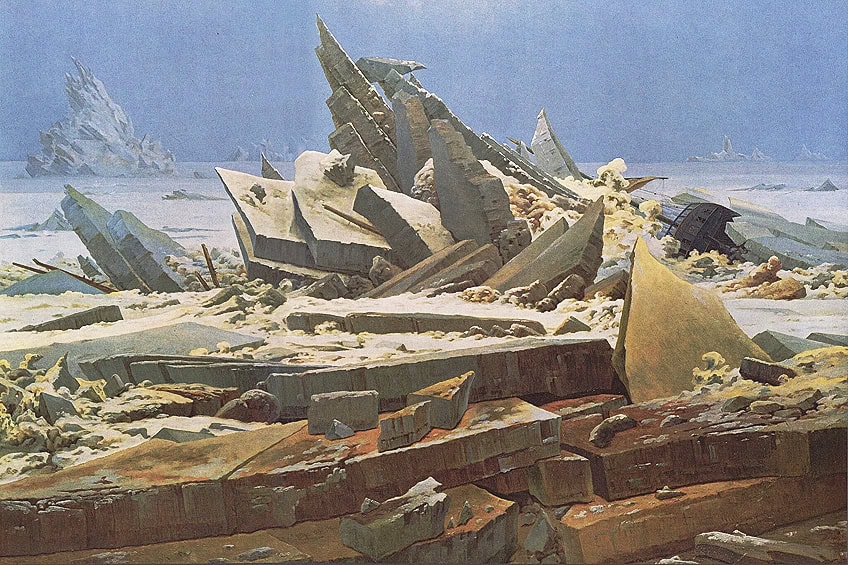“The Sea of Ice” by Caspar David Friedrich – Nature’s Fury
Caspar David Friedrich’s The Sea of Ice is a quintessential masterpiece of Romanticism, completed in 1824. This painting powerfully captures the sublime force of nature, depicting a shattered shipwreck ensnared within a towering, chaotic mass of jagged ice floes. Friedrich’s work exemplifies the Romantic fascination with the sublime and the insignificance of humanity against the grandeur and indifference of the natural world. The painting’s dramatic composition and cold, monochromatic palette evoke a profound sense of isolation and despair, making it a poignant commentary on human vulnerability and the relentless power of nature. Housed in the Hamburger Kunsthalle in Germany, The Sea of Ice remains one of Friedrich’s most iconic and influential works, emblematic of his innovative approach to landscape painting and his philosophical reflections on the human condition.
Key Takeaways
- The Sea of Ice highlights nature’s power over humans.
- Friedrich was inspired by real Arctic expeditions.
- The painting is a key piece in Romantic art history.
Historical Context
| Artist | Caspar David Friedrich (1774 – 1840) |
| Date Created | 1823 – 1824 |
| Medium | Oil on canvas |
| Genre | Landscape |
| Period/Movement | Romanticism |
| Dimensions (cm) | 96.7 × 126.9 |
| Series/Versions | Single version |
| Where Is It Housed? | Kunsthalle Hamburg, Hamburg, Germany |
| What It Is Worth | Not publicly auctioned; high historical and artistic value |
Painted between 1823 and 1824, The Sea of Ice by Caspar David Friedrich is a stunning example of German Romantic art. This oil on canvas depicts a shipwrecked vessel trapped in a tumultuous arctic landscape, its wooden frame crushed by jagged ice. The painting was first exhibited in 1824 and is now housed in the Kunsthalle Hamburg in Germany. It encapsulates the theme of human struggle against nature’s overwhelming power. Friedrich, known for his dramatic and emotive landscapes, drew inspiration from real-life Arctic expeditions of the early 19th century.

His work often explores themes of the sublime, portraying nature as both beautiful and terrifying. The Sea of Ice reflects Friedrich’s unique ability to evoke powerful emotions through his meticulous and moody compositions. This painting holds a special place in the history of art, offering a glimpse into the Romantic era’s fascination with nature’s raw and untamed beauty.
Through its intricate details and overwhelming scale, The Sea of Ice continues to captivate viewers and art enthusiasts alike.
Caspar David Friedrich’s Background
Caspar David Friedrich was a key figure in the German Romantic movement. Born in 1774 in Greifswald, he later trained at the Academy of Copenhagen. Moving to Dresden, he became known for his landscapes featuring deep emotional and spiritual themes. Friedrich’s work often explored themes of nature’s grandeur and human vulnerability. He was influenced by his friendship with Johann Gottlob von Quandt and Johann Martin von Rohden, among others, who shared his Romantic vision. By the early 1820s, Friedrich’s reputation as a leading landscape artist had been firmly established.
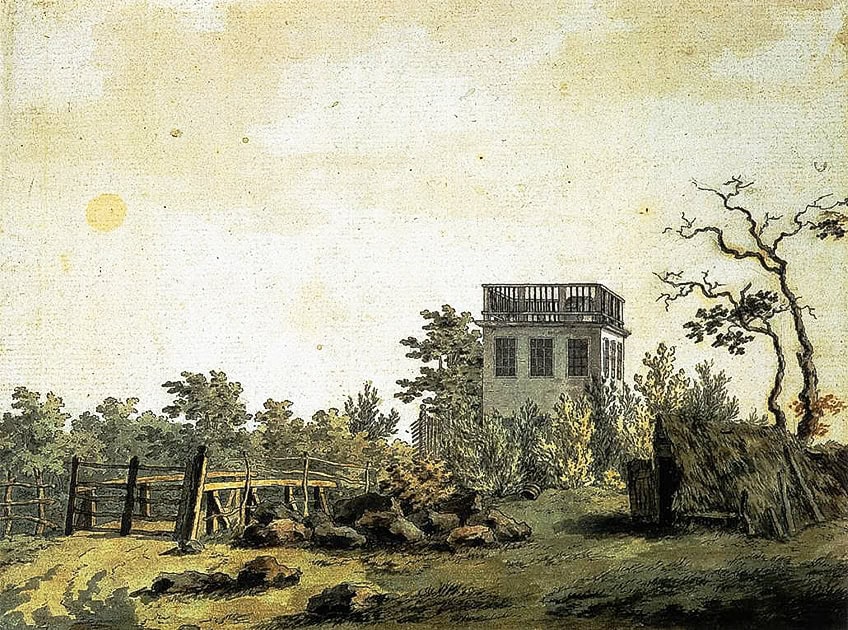
Influence of Arctic Exploration
The early 19th century witnessed significant interest in Arctic exploration. Expeditions like that of British explorer William Edward Parry, who sought the elusive Northwest Passage between 1819 and 1820, captured public and artistic imagination. Friedrich drew inspiration from these polar expeditions. The Sea of Ice reflects this fascination with the Arctic’s harsh and unforgiving environment. The painting portrays a shattered ice sheet with a shipwreck, symbolizing the potential futility of human endeavors against nature’s vastness.
This connection to contemporary events lent the painting immediate relevance.
Reception and Interpretation
The Sea of Ice was first exhibited at the Prague Academy Exhibition in 1824. Initially titled An Idealized Scene of an Arctic Sea, with a Wrecked Ship on the Heaped Masses of Ice, the painting evoked strong responses. Critics noted its dramatic portrayal of nature’s power, as it highlighed themes of despair and resilience. Viewers interpreted the work within the broader context of Romanticism, appreciating Friedrich’s mastery in conveying the sublime. The painting remains a seminal piece, reflecting the period’s artistic and intellectual currents.

Analysis of the Painting
Caspar David Friedrich’s The Sea of Ice presents a visually stunning and emotionally charged depiction of nature’s power and human vulnerability. Various elements such as color, composition, and thematic significance converge to create a rich, multi-layered masterpiece.
Subject Matter
The Sea of Ice portrays a dramatic shipwreck amid jagged ice floes in the Arctic Sea. Friedrich captures the ship’s remains crushed and trapped by towering ice shards. This representation highlights both the formidable power of nature and the fragility of human endeavors. The painting’s scene draws inspiration from real Arctic expeditions, specifically William Edward Parry’s 1819 – 1820 journey in search of the Northwest Passage, lending authenticity to the catastrophic imagery.
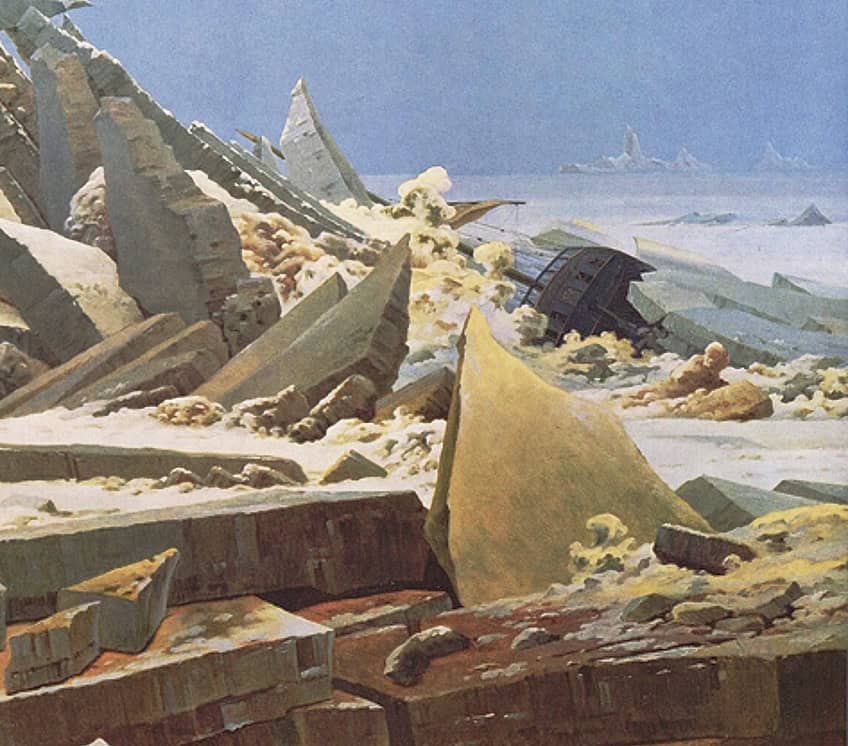
Use of Color and Line
Friedrich uses a cold, muted color palette to enhance the bleakness of the Arctic landscape. Predominantly blues and whites convey the chilling environment and emphasize the isolation and desolation of the scene. Sharp lines delineate the ice, contrasting with the softer lines of the wrecked ship.
This contrast between the jagged ice formations and the crushed vessel creates visual tension and draws the viewer’s eye toward the focal point: the shipwreck enveloped by nature’s relentless force.
Composition and Technique
The painting’s composition is carefully structured to emphasize the chaotic power of nature. Friedrich arranges the ice in a jagged, almost wave-like formation, leading the viewer’s gaze toward the center where the shipwreck lies. The use of oil on canvas allows him to achieve intricate detail and texture, from the rugged surfaces of the ice to the fragmented remains of the ship. His technique of applying multiple layers of thin paint (a method known as glazing) adds depth and luminance, making the ice appear both solid and translucent.
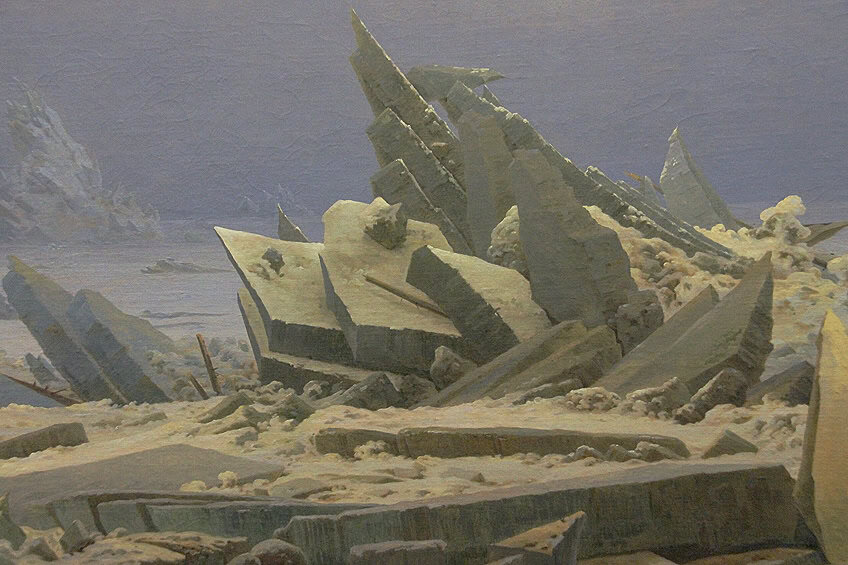
Themes of Nature and the Sublime
Nature’s supremacy and the sublime are central themes in The Sea of Ice. The painting evokes awe and terror, illustrating nature’s immense and uncontrollable strength. Friedrich’s depiction of the ice as a crushing, all-encompassing force highlights humanity’s vulnerability and insignificance in the face of nature. This theme aligns with the Romantic era’s fascination with the sublime—the combination of beauty and fear evoked by untamed nature.
The landscape itself becomes a powerful symbol of nature’s ability to evoke profound emotional responses.
Depiction of Wreckage and Death
The wreckage in the painting symbolizes both physical destruction and the broader theme of shattered hopes. The ship’s broken fragments scattered across the ice represent failed human aspirations and dreams crushed under the weight of nature. There is an implicit sense of death surrounding the scene, as the shipwreck implies lost lives and a stark reminder of human mortality. Friedrich’s meticulous attention to the details of the wreckage enhances the emotional impact, making the viewer acutely aware of the ship’s fate and the traumatic experience it represents.
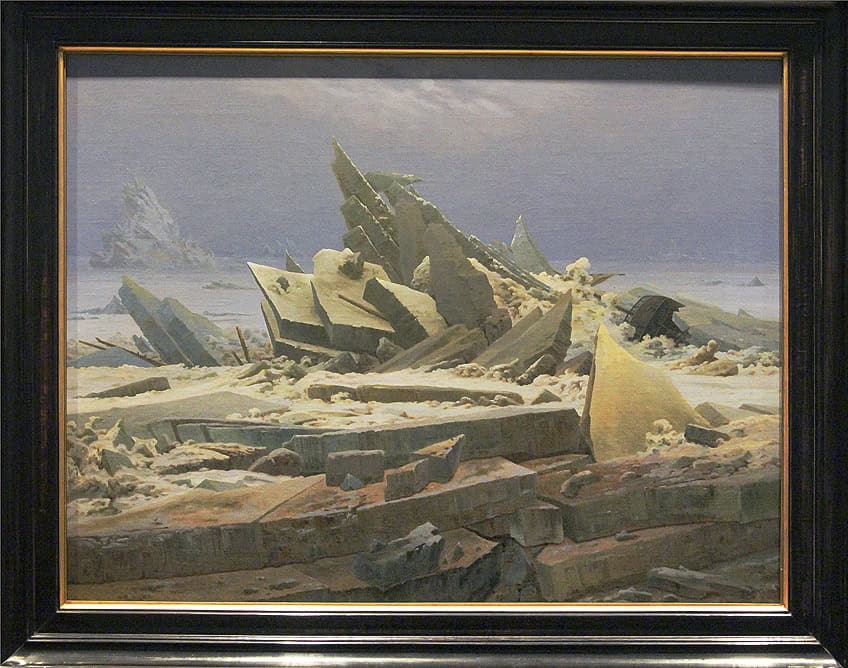
The Sea of Ice in Artistic Legacy
The Sea of Ice by Caspar David Friedrich has had a lasting impact on art, influencing numerous artists and being a notable comparison point in art history. It is an exemplary piece within the German Romantic movement.
Influence on Later Artists
Caspar David Friedrich’s The Sea of Ice influenced many artists who explored similar themes. Paul Nash, a British painter, created Totes Meer, which echoes the chaotic and dramatic feel of Friedrich’s ice scene. In contrast, Lawren Harris is known for his serene depictions of the Arctic, yet the stark beauty of his work can be seen as a gentler reflection of Friedrich’s influence.
Russell Potter, an author and scholar, discussed the “Arctic Sublime,” a concept that can be linked to Friedrich’s depiction of vast, frozen landscapes that evoke both awe and desolation.
While figures like Thom Mayne, an architect known for his design of the Sydney Opera House, didn’t directly draw from Friedrich’s work, the emphasis on dramatic, sweeping forms in both works demonstrates a shared appreciation for monumental and awe-inspiring visuals.
Comparisons in Art History
In the broader context of art history, The Sea of Ice stands out as a representation of the Romantic era’s fascination with nature’s power and beauty. It can be compared to works by artists such as J.M.W. Turner, whose tempestuous seascapes similarly evoke nature’s dramatic forces. The painting’s emotional intensity and emphasis on the sublime experience are also seen in works by later artists.
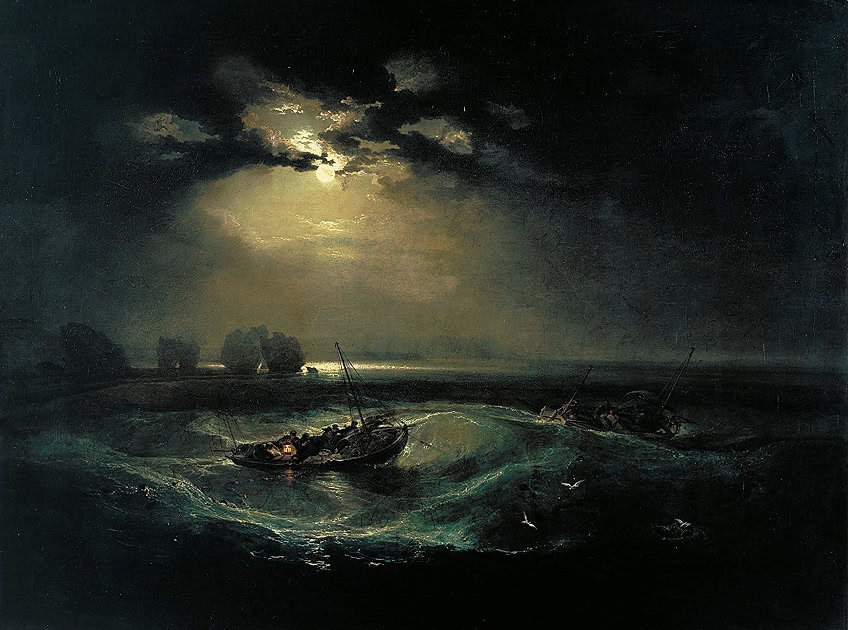
Looking at German Romantic artists specifically, Friedrich’s work is often compared to pieces by Carl Blechen and Philipp Otto Runge. These comparisons highlight a shared Romantic interest in depicting nature’s overwhelming and sometimes terrifying beauty. However, Friedrich’s focus on the Arctic adds a unique dimension, setting The Sea of Ice apart as a significant and enduring work within the Romantic landscape tradition.
The Sea of Ice stands as a monumental testament to the Romantic era’s exploration of the sublime and the human psyche’s confrontation with nature’s overwhelming power. Through its dramatic composition, stark color palette, and evocative depiction of a shipwreck amidst towering icebergs, the painting invites viewers to contemplate themes of isolation, despair, and the fragile nature of human endeavors. The Sea of Ice not only reflects Friedrich’s mastery in capturing the emotional and metaphysical dimensions of landscape art but also continues to resonate with contemporary audiences as a profound commentary on the inexorable forces of nature. Its enduring impact and significance in art history underscore Friedrich’s pivotal role in shaping the Romantic movement and his enduring legacy as one of the most influential landscape painters of his time.
Frequently Asked Questions
What Is the Historical Context of The Sea of Ice?
Painted between 1823 and 1824, The Sea of Ice captures a shipwreck in the Arctic. The painting was first shown at the Prague Academy exhibition in 1824. Before 1826, it was known as The Polar Sea. It reflects the period’s fascination with nature’s power and the sublime.
How Does The Sea of Ice Reflect Caspar David Friedrich’s Artistic Style?
Friedrich’s art often portrays nature’s vastness and power. The Sea of Ice shows this through the broken ice and the trapped ship. His use of light, shadow, and dramatic landscapes emphasizes the emotional and spiritual overtones found in much of his work.
What Techniques Did Caspar David Friedrich Use in The Sea of Ice?
Friedrich employed oil painting to create The Sea of Ice. His technique of layering colors helped to achieve depth and texture in the ice. The detailed depiction of the ice shards and the shipwreck illustrates his meticulous approach and skill in rendering natural elements.
Can The Sea of Ice Be Considered a Reflection of Romanticism?
Yes, The Sea of Ice is a prime example of Romanticism. This movement emphasized nature’s grandeur and human vulnerability. The painting showcases these themes by depicting an unforgiving Arctic landscape and a shattered ship, emphasizing nature’s overwhelming and uncontrollable forces.
Isabella studied at the University of Cape Town in South Africa and graduated with a Bachelor of Arts majoring in English Literature & Language and Psychology. Throughout her undergraduate years, she took Art History as an additional subject and absolutely loved it. Building on from her art history knowledge that began in high school, art has always been a particular area of fascination for her. From learning about artworks previously unknown to her, or sharpening her existing understanding of specific works, the ability to continue learning within this interesting sphere excites her greatly.
Her focal points of interest in art history encompass profiling specific artists and art movements, as it is these areas where she is able to really dig deep into the rich narrative of the art world. Additionally, she particularly enjoys exploring the different artistic styles of the 20th century, as well as the important impact that female artists have had on the development of art history.
Learn more about Isabella Meyer and the Art in Context Team.
Cite this Article
Isabella, Meyer, ““The Sea of Ice” by Caspar David Friedrich – Nature’s Fury.” Art in Context. June 18, 2024. URL: https://artincontext.org/the-sea-of-ice-by-caspar-david-friedrich/
Meyer, I. (2024, 18 June). “The Sea of Ice” by Caspar David Friedrich – Nature’s Fury. Art in Context. https://artincontext.org/the-sea-of-ice-by-caspar-david-friedrich/
Meyer, Isabella. ““The Sea of Ice” by Caspar David Friedrich – Nature’s Fury.” Art in Context, June 18, 2024. https://artincontext.org/the-sea-of-ice-by-caspar-david-friedrich/.


